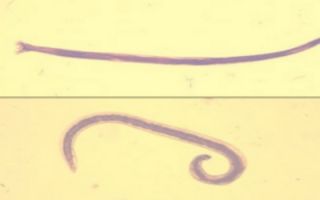Krivogolovka and necator are representatives of hookworms, helminths that cause the diseases hookworm and necatoriasis.
Read about necatoriasis and hookworm disease here .
Appearance
Worms are small worms of pale pink color, the size of female hookworms is 10-13 mm, males - 8-11 mm.
The necator is smaller than the crooked head (females - 9-11 mm, males - 5-9 mm).
In both types of helminths, the anterior end of the body is bent toward the dorsal side in the form of a hook. Both worms are hematophagous; the mouth opening of both is surrounded by an oral capsule, inside which there are 4 cuticular teeth in the crooked head, and 2 cutting plates in the necator.
Ancylostoma duodenale is thicker and absorbs about 0.15 ml of blood daily. Both species live in the intestines, attached to the mucous membrane of the upper small intestine. The lifespan of hookworm is about 5 years, and that of necator is 10-15 years.
Life cycle
After fertilization, the female hookhead lays up to 10,000 eggs daily, and the necator lays 3 times less. The eggs are released along with feces into the external environment.
Under optimal conditions (ambient temperature 32⁰C, high humidity, free access of oxygen, moist, humus-rich soil), a rhabditiform larva is formed inside the egg, which leaves the egg shell after 1-2 days and leads a free lifestyle, feeding on bacteria.
In these larvae, like in all free-living nematodes, the esophagus consists of 2 extensions separated by a constriction. In warm soil, rhabditiform larvae molt twice (on the 3rd and 5th day) and turn into filariform (invasive) larvae. This stage is located in the cap - the cuticle of the second larval stage, which it does not shed. Filariform larvae remain in the soil without feeding for up to 18 months. At the same time, they perform vertical migrations.
When it gets colder in winter, they descend to a depth of 1 meter, where they spend the winter. When the air temperature rises, they rise to the upper layers of the soil and even crawl onto plants. On moistened grass stems they can rise to a height of 22 cm, as a result of which they can get on human skin, even if he wears light shoes.
When spreading horizontally, they migrate within a radius of 10 m. Most larvae die within 6-9 weeks, but under optimal conditions they remain viable for 8-18 months.
Routes of human infection
The infective stage for humans is the filariform larva. There are two routes of infection - through the skin and through the mouth.
In the first case, the larva actively penetrates the skin when a person comes into contact with the soil. At the moment of insertion, she throws off the cover. Infection through the mouth is possible through contaminated vegetables, fruits, and water.
Japanese researchers have proven that infection with hookworm infection occurs primarily through ingestion of larvae, and with necatoriasis - through the skin. There are known cases of fetal infection during pregnancy of an infected woman.
Pathogenic effects on health
Regardless of the method of penetration, the migration of hookworm larvae into the human body is an obligatory stage in the development cycle of these parasites. The larvae penetrate the circulatory system through the skin, mucous membranes of the oral cavity, and intestines. Migration ends in the lungs, where the larvae destroy the walls of capillaries and alveoli, damaging lung tissue, causing the formation of infiltrates, hemorrhages, and pneumonic foci.
Next, the larva exits into the airways, then, together with sputum, enters the nasopharynx, oral cavity, then into the intestines when swallowed with saliva, water, or food.
Once in the intestine ( duodenum ), the larvae molt again, giving rise to adult worms, which penetrate deeply with their anterior end into the mucous membrane and begin feeding on blood.
Hookworms reach sexual maturity in 5-6 weeks. At the same time, female necator (Necator americanus) begins to release eggs. Crookedheads (Ancylostoma duodenale) have a period of delayed development: most females begin to secrete eggs 6-8 months after penetration through the skin into the human body.
The pathogenicity of hookworms is due to:
- damage to the skin due to the penetration of larvae and the addition of a secondary infection;
- intoxication by migrating larvae and the parasites themselves;
- damage to lung tissue during the migration of larvae;
- damage to the mucous membrane of the duodenum by cuticular teeth and plates of mature helminths;
- feeding on blood and prolonged bleeding of the mucous membrane due to the introduction of an anticoagulant into the blood against the background of a constant change in the place of fixation of the parasite to the mucous membrane.







